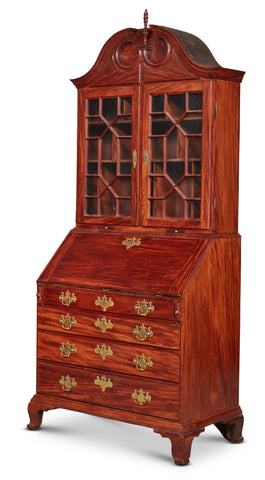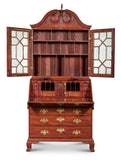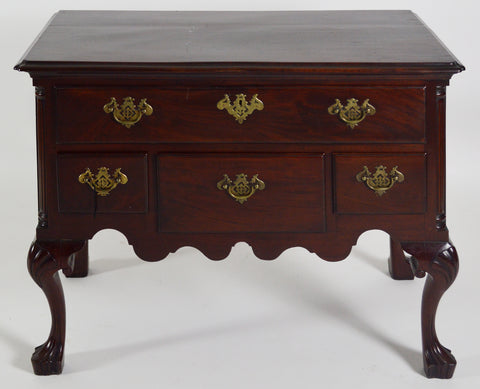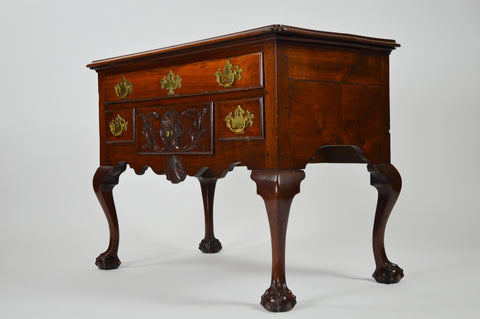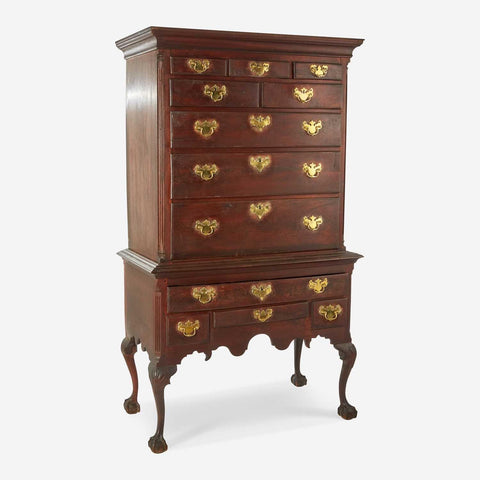VERY FINE AND RARE CHIPPENDALE CARVED AND FIGURED MAHOGANY DESK-AND-BOOKCASE
VERY FINE AND RARE CHIPPENDALE CARVED AND FIGURED MAHOGANY DESK-AND-BOOKCASE,
ATTRIBUTED TO ICHABOD COLE (1748-1841), WARREN, RHODE ISLAND,
CIRCA 1790
Height 93 ½ in. by Width 40 ¼ in. by Depth 22 in.
This desk-and-bookcase is attributed to Ichabod Cole (1748-1841), the Warren, Rhode Island shop joiner. It is very closely related to a desk-and-bookcase in a private collection with the inscription “Maid by / Ichabod / Cole / 1790”.[1] That desk stands as the only signed and dated piece by Cole that survives. Another nearly identical desk-and bookcase in a private collection is attributed to Ichabod Cole.[2] The three desks are illustrated and discussed by Patricia E. Kane in her article “Ichabod Cole: A Recently Discovered Rhode Island Furniture Maker” published in The Magazine Antiques in May 2007.[3]
All three desk-and-bookcases are of the same form and made of mahogany with similar overall proportions, a scrolled pediment with applied plaques, bookcase doors (glazed here and on the one in a private collection and block-and-shell carved on the signed desk), a slant-front opening to a block-and-shell-carved desk interior with pigeonhole drawer fronts, four graduated long drawers, and ogee bracket feet with small cusps. Like the signed desk, this example and the one in a private collection display several hallmarks of Cole’s work including the unusual floral motif on the prospect door and the unique marking system for the identification of drawer components. During construction, Cole marked his drawers from the bottom drawer up, rather than the more commonly found top drawer down. The fronts, sides, and backs are marked with a series of dotted vertical lines resembling the letter “i”. He marked the exterior drawer sides on the top edge with a “V” shaped incision pointing outward to indicate which side was the exterior. He added vertical lines next to the “V” to indicate placement within the series of drawers.
The desks also display the following construction characteristics identified by Kane: small interior drawers with small blocks glued to their exterior backs to act as drawer stops; pigeonhole drawers with bottom boards that are let into a V shaped groove in the drawer front; drawers sides (except those on the valance drawers) that are one-quarter to three eighths of an inch lower than the drawer fronts; bookcase section backboards comprised of lapped vertical boards nailed to rabbets in the bookcase sides and top; two piece white pine bottom boards; feet reinforced with white pine vertical corner blocks with abutting horizontal blocks; and the use of solid mahogany for the tops of the desks, behind the retaining molding for the bookcase.[4] Though influenced by Newport design, the desk-and-bookcases display features that do not follow Newport practice. These include the cornice lacking a deep cove and formed from two ogee-curved moldings, short central plinth blocks with two bold horizontal moldings on the bonnet, pigeonhole drawers with a compact round central arch flanked by sharply defined cusps, and a base molding with a fillet below the cyma curve. The ogee bracket feet are distinctive with a short ogee curve abutting the base molding, an elongated ogee descending vertically to the floor and a fillet extending under two-thirds of the foot.[5] Ichabod Cole was born in Warren, Rhode Island on December 17, 1748 to Isaac Cole (b. 1726) and his wife, Sarah (b. 1728).[6] He likely began his apprenticeship in about 1760 in an unidentified shop perhaps in Newport.[7] On December 19, 1773, he married Roby Cole (d. 1825), the daughter of Benjamin Cole (d. 1794). In 1774, he bought land in Warren and was identified as a shop joiner. He served as an ensign in the American Revolution in 1777 and was later granted a pension. Beginning in 1789, he served on the town council of Warren and represented the town at the General Assembly in the 1790s. Predeceased by his wife in 1825, Ichabod died in 1841 and his will was proved on February 20, 1841. He and his wife are buried in the Kickemuit Cemetery in Warren.
For additional pieces attributed to Ichabod Cole, see two slant-front desks, a chest-on-chest and a dining table included in the Rhode Island Furniture Archive.[8]
[1] See Patricia E. Kane, et al, Art and Industry in Early America: Rhode Island Furniture, 1650-1830 (New Haven, CT: Yale University Art Gallery, 2016): no. 79, p. 369
[2] See Rhode Island Furniture Archive, RIF 1876.
[3] See Patricia E. Kane, “Ichabod Cole: A Recently Discovered Rhode Island Furniture Maker,” The Magazine Antiques 172, no. 5 (May 2007): 116-17, fig. 7, 7a, 7b, and 7c.
[4] Ibid, p. 112.
[5] Ibid, p. 116.
[6] Ibid, p. 114. See also Patricia E. Kane, biography of Ichabod Cole, Rhode Island Furniture Archive at the Yale University Art Gallery
[7] Kane notes that circumstantial evidence suggests that Cole may have trained in Newport perhaps with the Lyndon family of joiners.
[8] Rhode Island Furniture Archive, RIF4068, RIF4308, RIF6050, and RIF5330.
We Also Recommend

